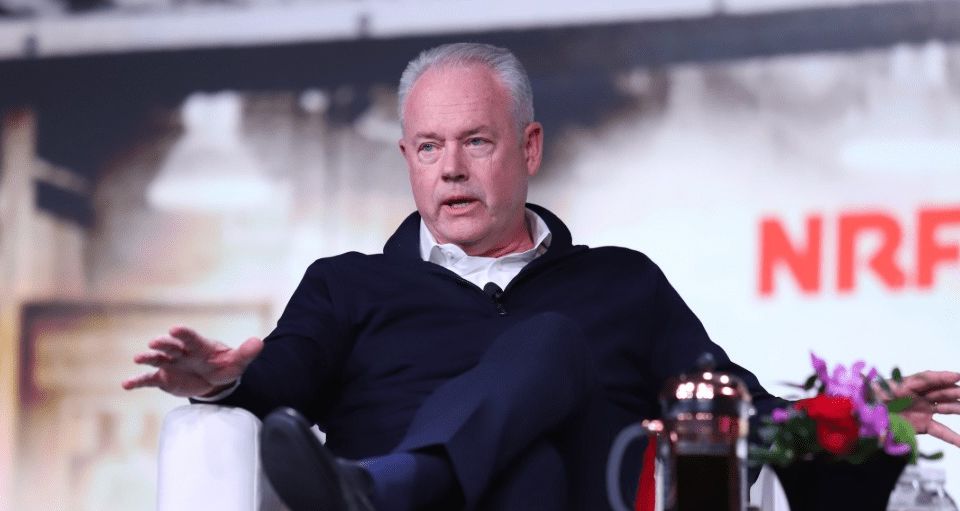Starbucks has long prided itself as the ultimate “third place” for consumers — a place where they can unwind outside of their home and workplace while still experiencing a community-like environment. Kevin Johnson, CEO of Starbucks, believes this focus on humanity in the store experience not only benefits the coffee giant in the long run, but also will be a major factor in how physical retail will succeed in 2020 and beyond.
In an NRF 2020 session, Johnson stressed the importance of human connection as a chief value proposition for Starbucks, even as the retailer becomes increasingly tech-driven and focused on developing its mobile ordering capabilities. Johnson even cited a study noting that one in five Americans suffer from some form of clinical health problem related to their mental wellbeing, with one of the contributing factors being the amount of time people spend buried in their mobile devices.
“We will not sacrifice creating that warm welcome environment,” Johnson said during the keynote. “As human beings, we were meant to interact with one another. It’s how we get energy, it’s how we get support when we’re dealing with adversity and it’s how we share joy and successes in our lives. Technology has done so much positive for the world, but it has contributed to some unhealthy outcomes as well, when it comes to enhancing human connection and enabling people to be present and feel a part of a community. I believe technology, if used in responsible and thoughtful ways, can also be the enabler of freeing up people to be more human and better serve humanity.”
Johnson emphasized the importance of the connection between employees and customers, and highlighted it as a major reason for the continued success at Starbucks. To maintain this connection, Johnson began talking to employees to see what daily tasks keep them from engaging with customers or leave them stuck working in back rooms, away from where they can engage with guests. With this knowledge in hand, he plans to explore ways to use technology in ways that build, rather than replace, customer interaction.
Advertisement
“I want to ensure we stay true to that approach,” Johnson said. “So we will pursue world-class technology, not just for the sake of technology, but in service of humanity and in support of our mission to inspire and nurture the human spirit one person, one cup, and one neighborhood at a time.“
AI-Powered ‘Deep Brew’ Optimizes The Barista-Customer Connection
One technology Johnson pointed to as a major differentiator for the shopper experience was the Deep Brew initiative: a custom-developed, AI-driven recommendation platform designed to serve customers with relevant product recommendations across multiple channels, including in-app ordering and digital menu boards. Additionally, Deep Brew enables Starbucks to bolster its upsell and cross-sell modifications in the drive thru, and has even improved the company’s voice ordering capabilities.
Under the Deep Brew initiative, Starbucks implements reinforced learning capabilities that allow the company to adapt to customer preferences and context over time, in areas including product categories, popular ingredients, price sensitivity, time of day, weather, and location.
“In many ways, Deep Brew and the focus on machine learning is all about finding ways to help humans have more time to be human,” Johnson said. “It’s not about robots replacing baristas, it’s about technologies that free up our baristas to better connect with one another and connect with customers. Deep Brew will do the calculations and figure out how much inventory to order per store. That frees up some number of hours or time people have to spend counting inventory and placing an order. Deep Brew will predict how many baristas we need on staff every 30 minutes of the day so that we are staffed in ways that we can serve customers, meet customer demand and dramatically simplify the scheduling of our departments.”
Starbucks Tryer Center Brings Idea To Action In 100 Days
Starbucks encourages its employees to get in on the technology ideation process as well. One example is the company’s Tryer Center in Seattle, an innovation lab designed to test new products without affecting the rest of the company’s day-to-day activities. The company developed its first pickup-only store (now deployed in Midtown Manhattan) at the location, and has developed and tested more than 130 projects since it opened in November 2018.
“We want to go from idea to action in 100 days, and then learn and adapt,” said Johnson. “Scale and complexity can become the enemy of speed. We went from a long-cycle innovation approach to a rapid-cycle innovation approach. In doing that, we embrace newness every time. And when we’re designing something, let’s look at it through the lens of: How will this affect the partner experience, and how will this affect the customer experience?”









